Over 30 years of anarchist writing from Ireland listed under hundreds of topics
Catholic church
Divorce .. Undermining the family? ( WSM pamphlet from 1st Divorce Referendum in 1986)
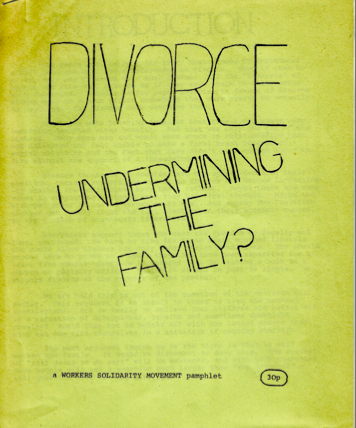 This pamphlet was produced by the Workers Solidarity Movement in the weeks before the 1986 referendum on whether or not to remove the constitutional ban on divorce. The vote was lost by a margin of almost 2:1, with 935,843 (63.48%) voting to keep the ban and 538,279 (36.52%) to remove it. A second referendum in 1995 saw the ban finally scrapped, with a result of 818,842 (50.28%) to 809,728 (49.72%).
This pamphlet was produced by the Workers Solidarity Movement in the weeks before the 1986 referendum on whether or not to remove the constitutional ban on divorce. The vote was lost by a margin of almost 2:1, with 935,843 (63.48%) voting to keep the ban and 538,279 (36.52%) to remove it. A second referendum in 1995 saw the ban finally scrapped, with a result of 818,842 (50.28%) to 809,728 (49.72%).
Alone on the far left, the WSM was heavily involved in this campaign and had two members elected to the National Executive of the Divorce Action Group. At the time they described their motivation as being to “increase personal freedoms” and “challenge the power of the Catholic bishops”. Read the full text of the pamphlet in the article.
Authoritarianism and the early Irish State
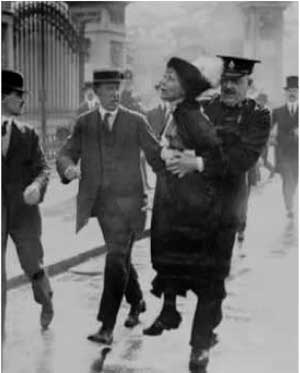 Fin Dwyer looks at the latter years of Ireland’s first post independence government, which having successfully suppressed political opposition and the workers’ movement, went on to “attack women and enforce their moral and ethical values on wider society”. From the clearing of prostitutes from the Monto and the filling of the Magdalene laundries to the institutionalisation of child abuse, he describes how the state’s close association with the Catholic Church played a decisive role in forming attitudes to women and sex that have had a devastating effect on Irish society that can still be felt today.
Fin Dwyer looks at the latter years of Ireland’s first post independence government, which having successfully suppressed political opposition and the workers’ movement, went on to “attack women and enforce their moral and ethical values on wider society”. From the clearing of prostitutes from the Monto and the filling of the Magdalene laundries to the institutionalisation of child abuse, he describes how the state’s close association with the Catholic Church played a decisive role in forming attitudes to women and sex that have had a devastating effect on Irish society that can still be felt today.
Anarchism and Religion
Workers Solidarity Movement position paper on Anarchism and Religion as ratified at November 2010 National Conference.
The bishops - no more credible on abortion than on divorce referendum
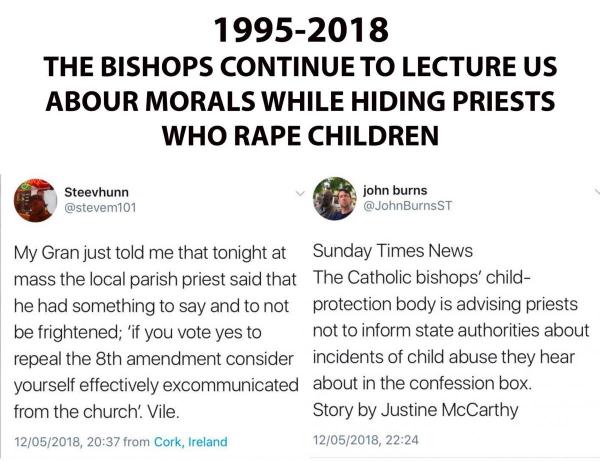 In the week before the 1995 divorce referendum the catholic bishops put out a statement commanding their flock to vote No. The WSM reacted to this by putting up posters reading 'The bishops; They hid priests who raped children and now they want to lecture us about morals.." illustrated with a photograph of Father Brendan Smyth who had raped at least 143 children and whose religious order had hid these actions from the police. The enquiry had found that "..despite knowing his history of abusing children, the Norbertine religious order moved Smyth to different dioceses where he abused more children.."
In the week before the 1995 divorce referendum the catholic bishops put out a statement commanding their flock to vote No. The WSM reacted to this by putting up posters reading 'The bishops; They hid priests who raped children and now they want to lecture us about morals.." illustrated with a photograph of Father Brendan Smyth who had raped at least 143 children and whose religious order had hid these actions from the police. The enquiry had found that "..despite knowing his history of abusing children, the Norbertine religious order moved Smyth to different dioceses where he abused more children.."
The Personal and Political within Catholic Ireland
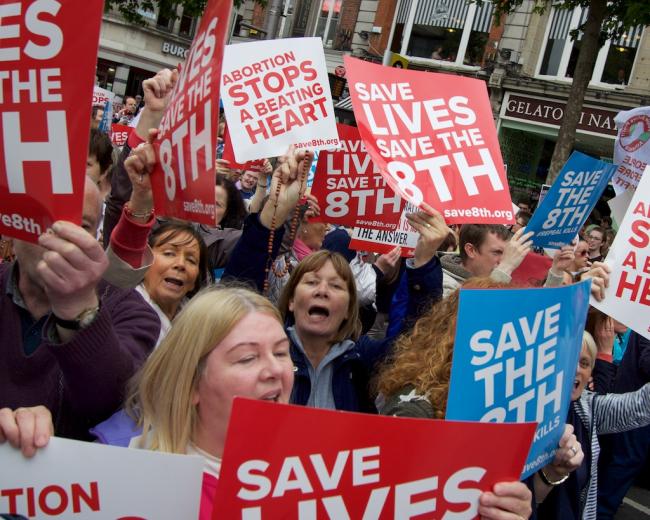 Sci-fi is a genre that I’ve never been able to get into and have never had the desire to change this. I find myself in the strange position now, however, of wishing I was some kind of sci-fi expert so that I could easily find a term for something that is half alive and half ghost. If there were such a term I’d use it to personify catholic Ireland, an institution that is still alive but dying with a ghost that wields most of its power.
Sci-fi is a genre that I’ve never been able to get into and have never had the desire to change this. I find myself in the strange position now, however, of wishing I was some kind of sci-fi expert so that I could easily find a term for something that is half alive and half ghost. If there were such a term I’d use it to personify catholic Ireland, an institution that is still alive but dying with a ghost that wields most of its power.
Catholic Ireland was a violent, brutal regime that existed – among many other reasons - to dehumanise, torture and inflict as much pain as possible on women. The church sexualised us from no age through instilling notions of modesty and chastity in us. They then shamed us and hid us away when we did have sex and the evidence was there to prove it. While in hiding they tortured us in laundries and traumatised us in Mother and Baby Homes.
Our Hospitals: Don't Give the Maternity Hospital to the Nuns - Holles Street Protest!
Protests took place across Ireland Saturday 22nd April to protest the plan by Health Simon Harris to give the new maternity hospital, which will cost 300 million to build, to the same nuns who ran the Magdeline laundaries! The Sisters of Charity ran the Drumcondra and Sean MacDermott Street laundaries where expectant and recent mothers were essentially imprisoned and required to provide free labour that the numns profited from.
Thousands of children were starved to death in Tuam and other state funded homes run by nuns in Ireland
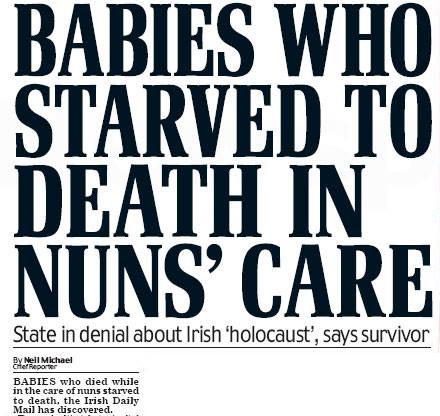 It is emerging that thousands of children were starved to death in state funded homes run by nuns in Ireland. The Daily Mail today carries a detailed report which quotes Philip Redmond, a survivor of Sean Ross Abbey Hospital, Roscrea, Co. Tipperary where of the 167 babies born in 1942, there were 72 deaths. Mr Redmond says "As far as Bessborough is concerned, there is little doubt in our minds that as many as 2,000 died while we believe another 1,200 died in Sean Ross Abbey" This figures are to be added to the estimated 796 bodies found in a waste tank in the grounds of then Tuam home - see the earlier piece on this page.
It is emerging that thousands of children were starved to death in state funded homes run by nuns in Ireland. The Daily Mail today carries a detailed report which quotes Philip Redmond, a survivor of Sean Ross Abbey Hospital, Roscrea, Co. Tipperary where of the 167 babies born in 1942, there were 72 deaths. Mr Redmond says "As far as Bessborough is concerned, there is little doubt in our minds that as many as 2,000 died while we believe another 1,200 died in Sean Ross Abbey" This figures are to be added to the estimated 796 bodies found in a waste tank in the grounds of then Tuam home - see the earlier piece on this page.
Water Charges Protesters are Living 'Anarchy Fantasy' Says Irish Catholic Editor
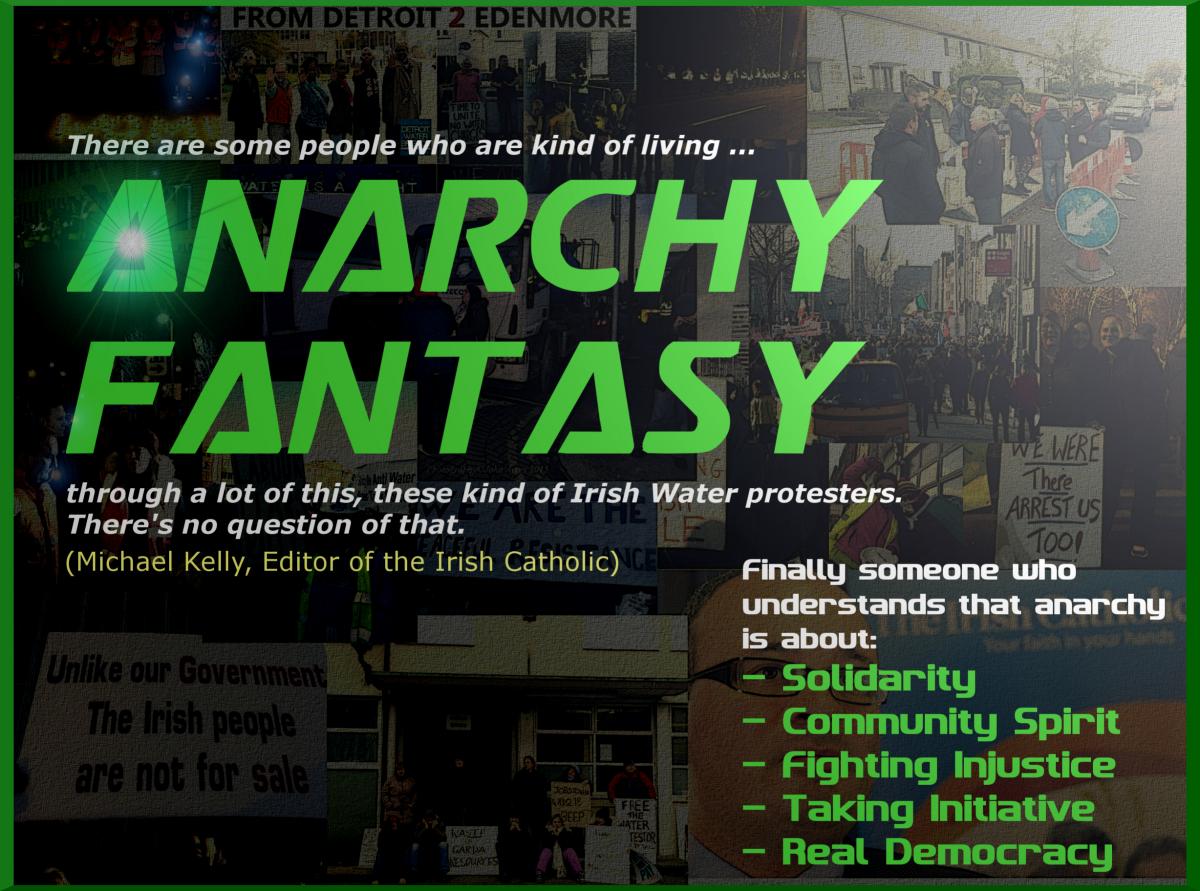 On Newstalk's Pat Kenny show Michael Kelly, editor of the Irish Catholic, said: 'There are some people who are kind of living ... anarchy fantasy through a lot of this, these ... kind of ... Irish Water protesters. There's no question of that'.
On Newstalk's Pat Kenny show Michael Kelly, editor of the Irish Catholic, said: 'There are some people who are kind of living ... anarchy fantasy through a lot of this, these ... kind of ... Irish Water protesters. There's no question of that'.
Mr. Kelly is surprisingly correct. The principles of anarchism are to be seen everywhere you turn in the struggle against the water charges.
People coming together in solidarity, building community spirit through the initiative of individuals, practising real democracy to organise against the injustice of the powerful, so that we may free ourselves from the burden of toil and arbitrary authority and live contentedly - this is the anarchy fantasy.
Galway Feminists Banner Drop off Cathedral
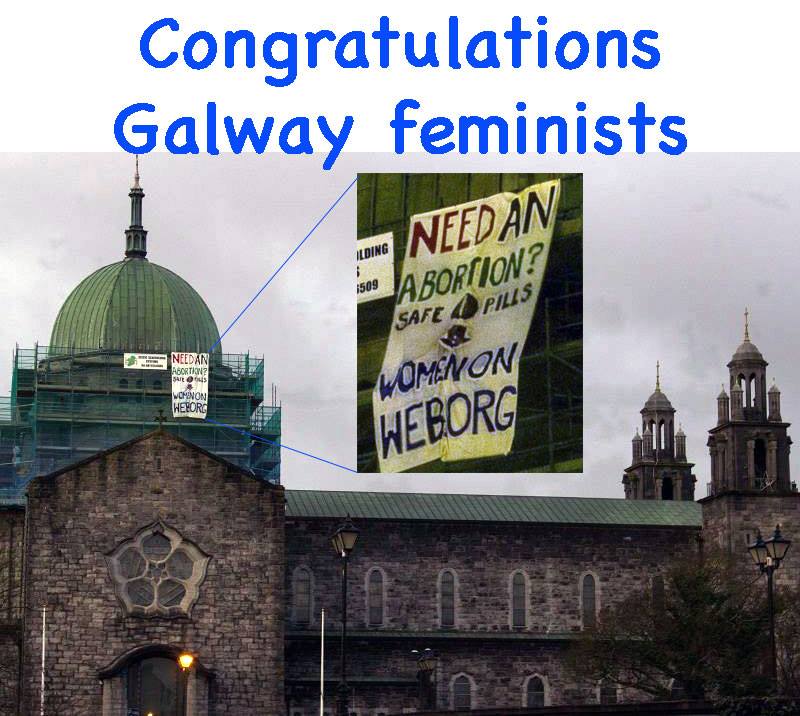 A few days ago the catholic bishops yet again dared to lecture people in Ireland with their statement against marriage equality. This morning Díobháil, a new Galway feminist group, has used Galway cathedral to speak out for and help the women trapped in unwanted pregnancies because of the bishops' role in another referendum, the 1983 anti choice referendum.
A few days ago the catholic bishops yet again dared to lecture people in Ireland with their statement against marriage equality. This morning Díobháil, a new Galway feminist group, has used Galway cathedral to speak out for and help the women trapped in unwanted pregnancies because of the bishops' role in another referendum, the 1983 anti choice referendum.
In the years since 1983 it emerged that the same bishops had conspired to hide priests who had raped children, not just on one or two but on many occasions. Despite that this same group of supposedly celibate men still continue to bother us with lectures opposing sexual freedom, bodily autonomy and even same sex relationships. The same bishops still have de facto control over most of our schools and many of our hospitals and community centres.
Tuam babies in sceptic tank story is one of state church co-operation into our collective present
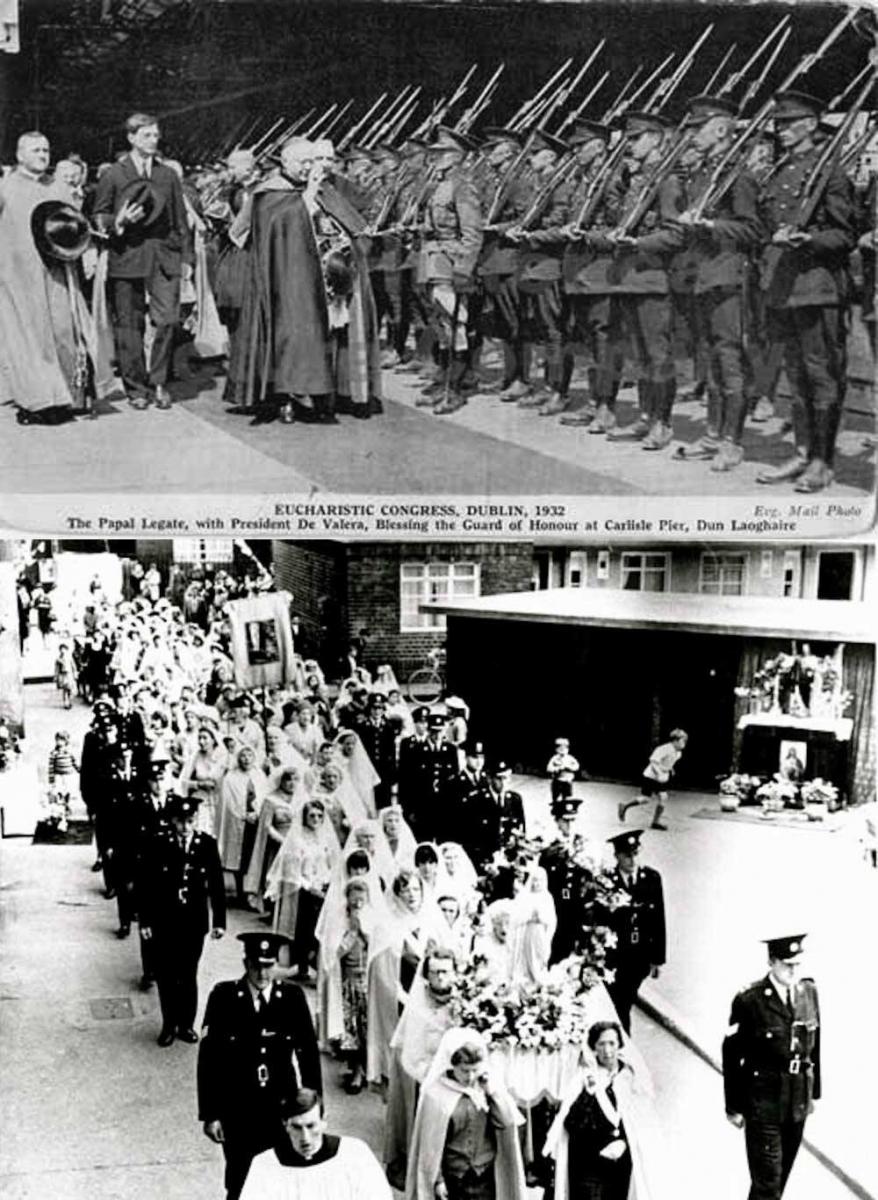 The mass grave in Tuam isn't simply a story of a handful of evil nuns acting out of sight and discovered 80 years too late. It's the story of the long and protracted relationship between the Irish state and the Catholic church as illustrated by these two photos from the 1930s and 1950s.
The mass grave in Tuam isn't simply a story of a handful of evil nuns acting out of sight and discovered 80 years too late. It's the story of the long and protracted relationship between the Irish state and the Catholic church as illustrated by these two photos from the 1930s and 1950s.
The first is one of many scenes from the 1932 Eucharistic Congress, a few short years after the Tuam home went into operation. The congress saw the Irish state lay on an enormous pageant to cement its relationship with the church as part of the process of recasting its control over the population through the promotion of a regressive religious ideology that marginalised independent women, queers and anyone else who didn't toe the line.

